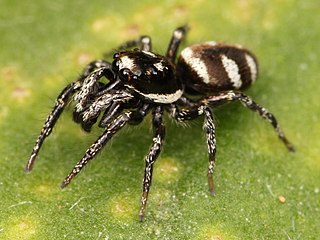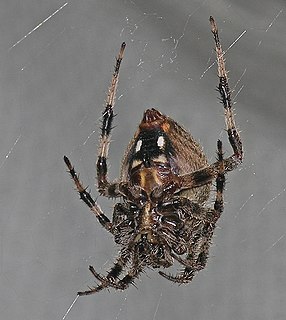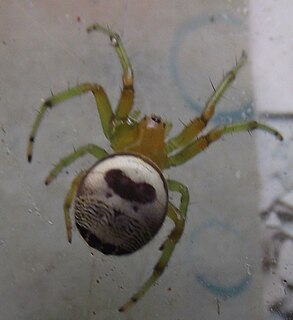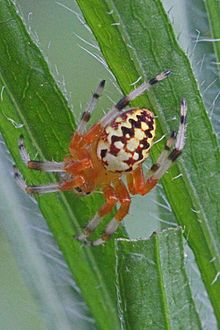
The spider species Araneus diadematus is commonly called the European garden spider, diadem spider, orangie, cross spider and crowned orb weaver. It is sometimes called the pumpkin spider, although this name is also used for a different species, Araneus marmoreus. It is an orb-weaver spider found in Europe, where it is native, and North America, where it is introduced.

Austracantha is a genus of spider with a single species, Austracantha minax, commonly known as the jewel spider or the Christmas spider. It is a member of the family Araneidae and is endemic to Australia. They are relatively small spiders, reaching a maximum total body length of only around 12 mm (0.47 in) for females, and 5 mm (0.20 in) for males. Their abdomen has six distinctive projections ("spines") that makes them easy to identify. They are predominantly a shiny black, with variable white, yellow, and orange patterns. Melanistic forms also occur during autumn. They are facultatively gregarious, and can be found in large aggregations of overlapping orb webs. They feed on small flying insects that get entangled in their webs. They are harmless to humans, though the webs can be a nuisance for bushwalkers. They are most abundant during the summer months.

The spider species Tegenaria domestica, commonly known as the barn funnel weaver in North America and the domestic house spider in Europe, is a member of the funnel-web family Agelenidae.

The zebra jumping spider is a common jumping spider of the Northern Hemisphere. Their common name refers to their vivid black-and-white colouration, whilst their scientific name derives from Salticus from the Latin for “dancing”, in reference to their agility, and the Greek scenicus, translating to “theatrical” or “of a decorative place,” in reference to the flashy, zebra-like coloration of the species.

Salticus is a genus of the family Salticidae. Salticus is the type genus for the family Salticidae.

Araniella cucurbitina, sometimes called the "cucumber green spider", is a spider of the family Araneidae.

Zygiella x-notata, sometimes known as the missing sector orb weaver or the silver-sided sector spider, is a spider species in the family Araneidae. They are solitary spiders, residing in daily-spun orb webs. Z. x-notata is a member of the genus Zygiella, the orb-weaving spiders. The adult female is easily recognized by the characteristic leaf-like mark on her posterior opisthosoma, caudal to the yellow-brown cephalothorax.

Araneus cavaticus, commonly known as the barn spider, is a common orb-weaver spider native to North America. They are around three-quarters of an inch (20 mm) in length and are usually yellow and brown in color. They often construct their webs in wooden human structures, hence their common name. The species is notable for being the basis for the character Charlotte in the book Charlotte's Web by American writer E. B. White.

Gasteracantha cancriformis is a species of orb-weaver spider. It is widely distributed in the New World.

The book Svenska Spindlar or Aranei Svecici is one of the major works of the Swedish arachnologist and entomologist Carl Alexander Clerck and was first published in Stockholm in the year 1757. It was the first comprehensive book on the spiders of Sweden and one of the first regional monographs of a group of animals worldwide. The full title of the work is Svenska Spindlar uti sina hufvud-slägter indelte samt under några och sextio särskildte arter beskrefne och med illuminerade figurer uplyste – Aranei Svecici, descriptionibus et figuris æneis illustrati, ad genera subalterna redacti, speciebus ultra LX determinati, and included 162 pages of text and six colour plates. It was published in Swedish, with a Latin translation printed in a slightly smaller font below the Swedish text.

Araneus angulatus is a species of orb-weaving spiders found in the Palearctic realm. It resembles the European garden spider, Araneus diadematus, but has distinctive tubercles on its abdomen. The species was first described in Aranei Svecici in 1757, where it was the first species described, making Araneus angulatus the first scientific name of an animal that is still in use.

Neoscona crucifera is an orb-weaver spider in the family Araneidae. It is found in the United States from Maine to Florida in the east, to Minnesota in the Midwest, to Arizona in the southwest, southern California coastal communities and in Mexico. Its common names include Hentz orbweaver (after Nicholas Marcellus Hentz, spotted orbweaver, and barn spider. The name "barn spider" is also commonly used for a different spider, Araneus cavaticus.

Neoscona domiciliorum, commonly known as the spotted orbweaver or redfemured spotted orbweaver, is a spider in the family Araneidae. The specific epithet domiciliorum means "of dwellings" in Latin and refers to the fact that this species is often found living on buildings. Their bites are not known to cause serious harm in humans.

Agalenatea redii is a species of 'orbweavers' belonging to the family Araneidae subfamily Araneinae.

Araneus mitificus, commonly known as the kidney garden spider or pale orb weaver, is a species of orb-weaver spider found in South, East, and Southeast Asia.

Xysticus cristatus, the common crab spider, is a European spider from the family Thomisidae.

Phylloneta sisyphia, the mothercare spider, is a species of comb-footed spider from the genus Phylloneta.

Araneus trifolium, the shamrock orbweaver, is a species of orb weaver in the family Araneidae. It is found throughout the USA and in Canada.
The abdomen of Araneus trifolium can have various colors. Most commonly, it is seen in a beige or brown color. Occasionally, the abdomen of the spider has a greenish touch to the brown color or it may even be yellow or orange. In the latter case, Araneus trifolium is sometimes confused with the orange orb weaver species Araneus marmoreus, also called pumpkin spider. The shamrock spider can be distinguished from other orb weaver species by the several white dots on its back. The legs of Araneus trifolium are usually brown or beige colored with several white bands around the joints.
The shamrock spider creates a web to catch its prey. Small flying insects who fly into the web will get stuck in the sticky net. The web of an orb weaver can be up to two feet (60cm) in diameter.
The bite of a shamrock spider can be painful but it is not dangerous for humans with effects comparable to a bee sting.

Araniella displicata, the sixspotted orbweaver, is a species of orb weaver in the spider family Araneidae. It is found in North America, Europe, a range from Russia to Kazakhstan, China, Korea, and Japan.

Araneus grossus is a orb-weaver spider species. The species is one of the largest orb-weaver spiders in Europe. It is found in South and Southeast Europe and Central Asia.






















